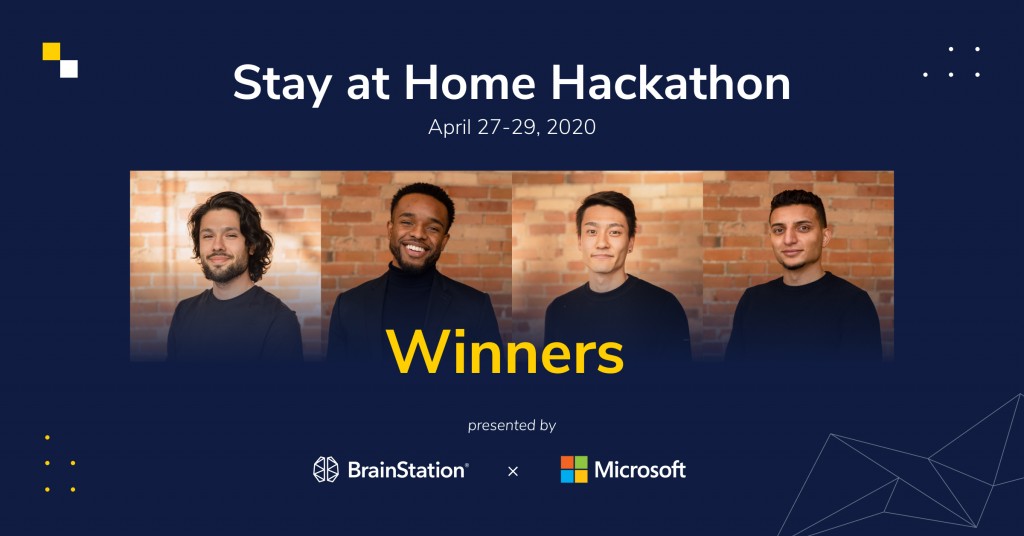BrainStation Winter 2022 Project Showcase
BrainStation bootcamp graduates recently showcased their accomplishments and newly developed digital skills at our Virtual Demo Day.
Our Story
Learn about who we are, our vision and how we’re changing the future of work.
Testimonials
Hear from our students on how BrainStation has helped them build successful careers.
Careers
Looking to join our team? View our open positions across the globe.
Press and Media
Resources and contact information for our media partners.

This last month, graduates had the opportunity to participate in our first stay-at-home hackathon (in partnership with Microsoft).
Each team had three days to design a solution for a better work-from-home experience that could integrate with the Microsoft Teams video chat software. After a few intense days of work and collaboration, the judges were seriously impressed with the results.

We spoke with the winning team: Pablo Lopez Castillo (UX Design), Jung Oh (UX Design), Ali Eddeb (Data Science), and Nick Mahon (Data Science). Together, the alumni designed FocusBuddy, a productivity app to help you stay focused on your tasks.
Having recently completed their full-time diploma programs at BrainStation, the graduates were eager to test their new skills with a challenge from a tech giant like Microsoft.
“By participating in this hackathon, my hope was that I would be exposed to the types of challenges or projects Microsoft employees get to tackle, as well as how they solve them,” Oh said.
For their project, the winning team wanted to reflect the current conditions professionals face when working from home. “We found that productivity was a primary issue remote workers face due to a variety of reasons. One of the most prominent pain points users had with productivity was that they had trouble maintaining self-discipline when attempting to thwart distractions (such as a cell phone),” the team explained.
The team decided to focus on developing a Microsoft Teams add-on called FocusBuddy, which helps boost remote productivity.
FocusBuddy:

Working remotely, the team used a plethora of tools to iterate, create, collaborate, and test. The Designers relied on Sketch, Figma, and Invision, while the Data Scientists used Sublime Text 3, Anaconda Prompt, and Jupyter Notebooks. Of course, Microsoft Teams also supported communication and collaboration to keep them working together.
“Seeing our concept come to life within the time constraints was satisfying as we all had pivotal roles,” Castillo said, explaining that there were many proud moments amongst the team. As a bonus, the team created a product commercial which really tied the whole presentation together.
Eddeb for one was impressed by the team dynamics. “We were able to criticize our ideas well and did not fall into groupthink. We were able to delegate tasks effectively and we overall had a good time working together.”
Similarly, Oh enjoyed working with Data Scientists to leverage unique solutions. “We were able to ask our Data Scientists to provide thought-provoking perspectives, educate ourselves regarding the possibilities of data, and implement innovative solutions as a result.”
Mahon, meanwhile, was pleased with the way the UX team brought their ideas into reality. “Bringing such a polished look to an otherwise rough idea was incredible.”

But it wasn’t easy.
Starting the project, in particular, posed a challenge. “There were just so many ways to approach the improvement of the work-from-home experience,” the team said. “We spent a significant amount of time redefining our problem space to achieve what we felt to be the best solution.”
As they moved forward, the team relied on what they learned at BrainStation to find success.
“From the plethora of knowledge gained in completing the Data Science program at BrainStation, the most relevant of it was learned during 3D day,” Mahon said. BrainStation 3D is a day in which students from the UX, Data, and Web Dev platforms come together for a day-long collaborative competition to practice working cross-functionally. “Working with UX Designers beforehand and having an idea of how our work complements one another went a long way in arriving at our final product,” said Mahon.
The others agreed that BrainStation gave them the tools to work well as a multidisciplinary group. Plablo shared that the program taught him skills that helped him with “navigating the problem space and understanding how to extract insights and translating research to identify user needs is a skill I am always working to improve on.”
Oh agreed that the diploma program taught them how to approach problems in a team setting. “This skill was useful in the hackathon because it enabled our team to get all of our ideas on the table, use our individual strengths and knowledge to analyze and select an idea to move work with, and apply the technical skills we have been trained in.”
The team encourages other recent graduates and others seeking a role in UX or Data to practice, practice, practice. Edebb says the best advice he’s received is to continue working on projects. “Once you have foundational knowledge, try to implement what you have learned by working on projects.”
After all, Mahon reminds us: “The slogan that is heard throughout our time at BrainStation is based on being ‘a lifetime learner.’ My advice is to do exactly that; there is never nothing new to learn and the more you know, the more directions you will be able to take your career.”
Get the latest on upcoming courses, programs, events, and more — straight to your inbox.

You have been added to our mailing list, and will now receive updates from BrainStation.